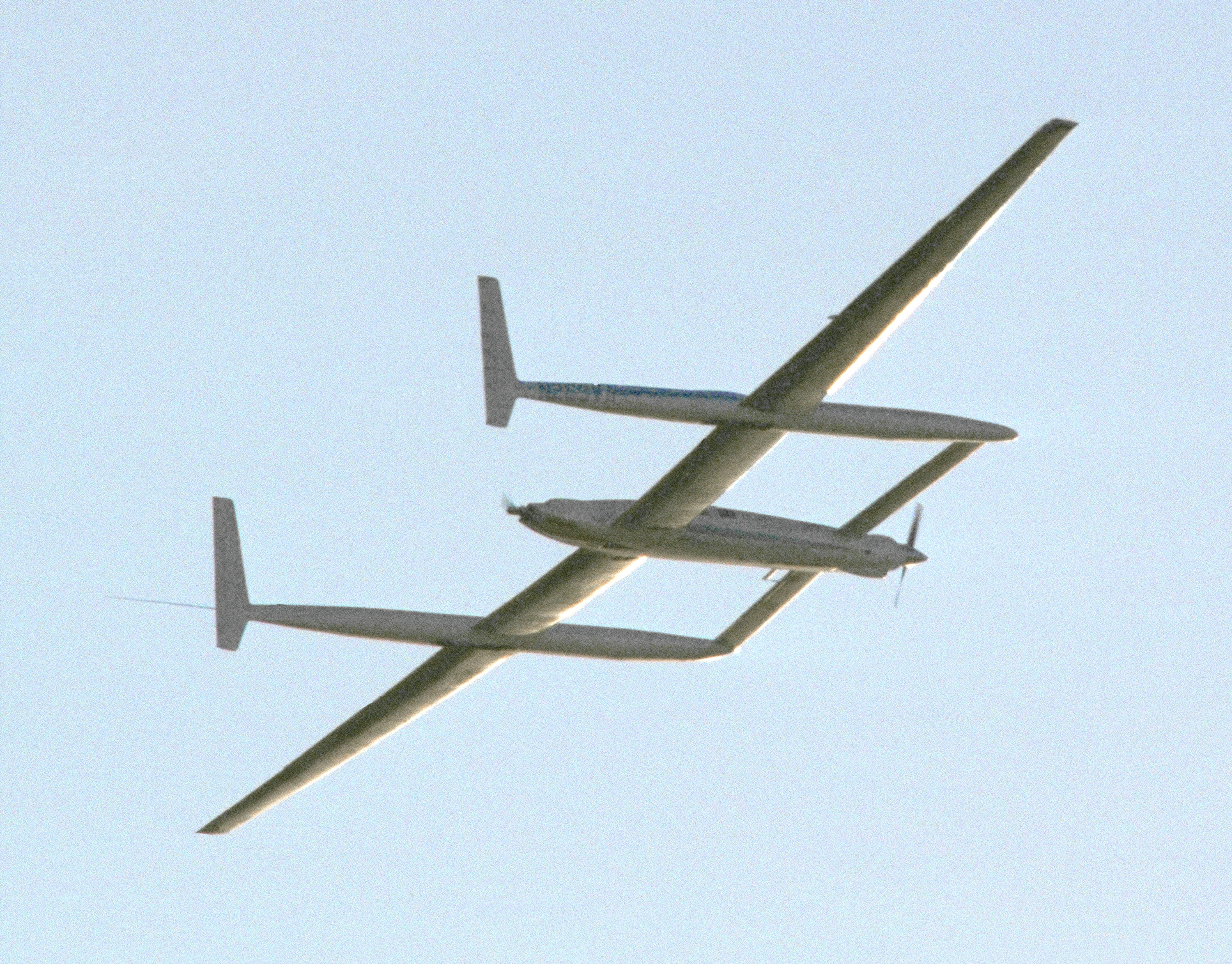- Rutan Voyager
infobox Aircraft
name =Model 76 Voyager
type =Record plane
manufacturer = Rutan Aircraft Factory
caption =Voyager returning from its flight
designer =Burt Rutan
first flight =22 June 1984
introduced =1984
retired =1987
status =
primary user =
more users =
produced =
number built =1
unit cost =
variants with their own articles =The Model 76 Voyager was the first
aircraft to fly around the world without stopping or refueling. It was piloted byDick Rutan andJeana Yeager , who took off fromEdwards Air Force Base 's 15,000 foot (4,600 m) runway in theMojave Desert onDecember 14 ,1986 . Their flight ended successfully 9 days, 3 minutes and 44 seconds later, onDecember 23 . They flew westerly 26,366 statute miles (42,432 km; the FAI accredited distance is 40,212 km) [cite web|url=http://records.fai.org/general_aviation/aircraft.asp?id=2696|title=Official FAI database|accessdate=2007-09-05] at an average altitude of 11,000 feet (3.4 km). This definitively broke a previous record set by aUnited States Air Force crew piloting aBoeing B-52 that flew 12,532 miles (20,168 km) in 1962.Record flight
Voyager's takeoff took place at 8:01 AM local time. As the plane accelerated, the tips of the wings, which were heavily loaded with
fuel , were damaged as they scraped against the runway (see photo below), ultimately causing pieces (winglets) to break off at both ends. The aircraft accelerated very slowly and needed approximately 14,200 feet (2.7 mi)(4.3 km) of the runway to gain enough speed to lift from the ground, the wings arching up dramatically just before take-off. During the flight, the two pilots had to deal with extremely cramped quarters. To reduce stress, the two intended to fly the plane in three-hour shifts, but this did not prove to be very successful and they became extremely fatigued.The plane also continuously reminded the pilots of its pitch instability and fragility. They had to maneuver around bad weather numerous times, most perilously around the 600 mile (1,000 km) wide Typhoon Marge.
Libya denied access to the country'sairspace , forcing precious fuel to be used. As they nearedCalifornia to land, a fuel pump failed and had to be replaced with its twin pumping fuel from the other side of the aircraft. The plane safely came back toEarth , touching down at 8:06 AM at the same airfield. The average speed for the flight was 116 miles per hour (187 km/h).Aircraft development
The aircraft was first imagined by Jeana Yeager, Dick and his brother
Burt Rutan as they were at lunch in 1981. Like many other inventions, the initial idea was first sketched out on the back of anapkin . Voyager was built inMojave, California , over a period of 5 years. The Voyager was built mainly by a group of volunteers working under both the Rutan Aircraft Factory and an organization set up under the name Voyager Aircraft (it was not, as is sometimes believed, built byScaled Composites ). [http://scaled.com/projects/voyager.html Scaled Composites' Voyager web page] ]The
airframe , largely made offiberglass ,carbon fiber , andKevlar , weighed 939 pounds (426 kg) when empty [ [http://collections.nasm.si.edu/code/emuseum.asp?style=single¤trecord=3&page=search&profile=objects&searchdesc=rutan%20voyager&quicksearch=rutan%20voyager&newvalues=1&newstyle=expanded&newcurrentrecord=3 Smithsonian National Air and Space Museum] ] . However, when it was fully loaded before the historic flight, it weighed 9,694.5 pounds (4 397 kg). The aircraft had an estimatedlift to drag ratio (L/D) of 27 [David Noland, "Steve Fossett and Burt Rutan's Ultimate Solo: Behind the Scenes," "Popular Mechanics", Feb. 2005 ( [http://www.popularmechanics.com/science/air_space/1262012.html?page=3 web version] )] .Voyager had front and rear propellers, powered by separate engines. The rear engine, a water-cooled Teledyne Continental IOL-200, was planned to be operated throughout the flight. The front engine, an air-cooled Teledyne Continental O-240, was operated to provide additional power for takeoff and the initial part of the flight at heavy weights.
Voyager is now on display at the
Smithsonian Institution 'sNational Air and Space Museum inWashington, DC .pecifications
aerospecs
ref= [http://collections.nasm.si.edu/code/emuseum.asp?style=browse¤trecord=1&page=search&profile=objects&searchdesc=rutan%20voyager&quicksearch=rutan%20voyager&newvalues=1&newstyle=single&newcurrentrecord=3 Smithsonian National Air and Space Museum]
met or eng?=enggenhide=
crew=Two pilots
capacity=
length m=8.90
length ft=29
length in=2
span m=33.80
span ft=110
span in=8
swept m=
swept ft=
swept in=
rot number=
rot dia m=
rot dia ft=
rot dia in=
dia m=
dia ft=
dia in=
width m=
width ft=
width in=
height m=3.10
height ft=10
height in=3
wing area sqm=
wing area sqft=empty weight kg=1020.6
empty weight lb= 2250
gross weight kg=4397.4
gross weight lb=9694.5eng1 number=1
eng1 type=TeledyneContinental O-240
eng1 kw= 100
eng1 hp=130eng2 number=1
eng2 type=Teledyne Continental IOL-200
eng2 kw=81
eng2 hp=110perfhide=
max speed kmh=196
max speed mph=122
max speed mach=
cruise speed kmh=
cruise speed mph=
range km=42,212
range miles=24,986
endurance h=216
endurance min=
ceiling m=
ceiling ft=
glide ratio=
climb rate ms=
climb rate ftmin=
sink rate ms=
sink rate ftmin=ee also
*The
Virgin Atlantic GlobalFlyer was a jet-powered aircraft also designed by Burt Rutan and built by Scaled Composites, in whichSteve Fossett made the first "solo" nonstop flight around the world in 2005.
*VSS Voyager is another Burt Rutan designed craft.References
*David H. Onkst. [http://www.centennialofflight.gov/essay/Explorers_Record_Setters_and_Daredevils/rutan/EX32.htm Dick Rutan, Jeana Yeager, and the Flight of the Voyager.] U.S. Centennial of Flight Commission.
Wikimedia Foundation. 2010.
